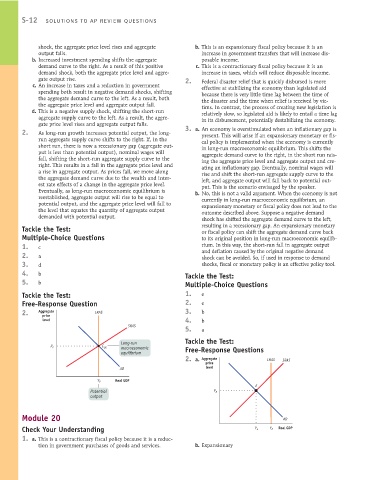Page 858 - Krugmans Economics for AP Text Book_Neat
P. 858
S-12 SOLUTIONS TO AP REVIEW QUESTIONS
shock, the aggregate price level rises and aggregate b. This is an expansionary fiscal policy because it is an
output falls. increase in government transfers that will increase dis-
b. Increased investment spending shifts the aggregate posable income.
demand curve to the right. As a result of this positive c. This is a contractionary fiscal policy because it is an
demand shock, both the aggregate price level and aggre- increase in taxes, which will reduce disposable income.
gate output rise. 2. Federal disaster relief that is quickly disbursed is more
c. An increase in taxes and a reduction in government effective at stabilizing the economy than legislated aid
spending both result in negative demand shocks, shifting because there is very little time lag between the time of
the aggregate demand curve to the left. As a result, both the disaster and the time when relief is received by vic-
the aggregate price level and aggregate output fall. tims. In contrast, the process of creating new legislation is
d. This is a negative supply shock, shifting the short - run relatively slow, so legislated aid is likely to entail a time lag
aggregate supply curve to the left. As a result, the aggre- in its disbursement, potentially destabilizing the economy.
gate price level rises and aggregate output falls.
2. As long - run growth increases potential output, the long - 3. a. An economy is overstimulated when an inflationary gap is
run aggregate supply curve shifts to the right. If, in the present. This will arise if an expansionary monetary or fis-
cal policy is implemented when the economy is currently
short run, there is now a recessionary gap (aggregate out- in long - run macroeconomic equilibrium. This shifts the
put is less than potential output), nominal wages will aggregate demand curve to the right, in the short run rais-
fall, shifting the short - run aggregate supply curve to the ing the aggregate price level and aggregate output and cre-
right. This results in a fall in the aggregate price level and ating an inflationary gap. Eventually, nominal wages will
a rise in aggregate output. As prices fall, we move along rise and shift the short - run aggregate supply curve to the
the aggregate demand curve due to the wealth and inter- left, and aggregate output will fall back to potential out-
est rate effects of a change in the aggregate price level. put. This is the scenario envisaged by the speaker.
Eventually, as long - run macroeconomic equilibrium is b. No, this is not a valid argument. When the economy is not
reestablished, aggregate output will rise to be equal to currently in long - run macroeconomic equilibrium, an
potential output, and the aggregate price level will fall to expansionary monetary or fiscal policy does not lead to the
the level that equates the quantity of aggregate output outcome described above. Suppose a negative demand
demanded with potential output.
shock has shifted the aggregate demand curve to the left,
Tackle the Test: resulting in a recessionary gap. An expansionary monetary
or fiscal policy can shift the aggregate demand curve back
Multiple-Choice Questions to its original position in long -run macroeconomic equilib-
1. c rium. In this way, the short- run fall in aggregate output
2. a and deflation caused by the original negative demand
shock can be avoided. So, if used in response to demand
3. d shocks, fiscal or monetary policy is an effective policy tool.
4. b Tackle the Test:
5. b Multiple-Choice Questions
Tackle the Test: 1. e
Free-Response Question 2. e
2. Aggregate LRAS 3. b
price
level 4. b
SRAS
5. a
Tackle the Test:
Long-run
macroeconomic Free-Response Questions
P E E LR
equilibrium
2. a. Aggregate LRAS SRAS
price
AD level
Y P Real GDP
E
Potential P E
output
Module 20 AD
Check Your Understanding Y E Y P Real GDP
1. a. This is a contractionary fiscal policy because it is a reduc-
tion in government purchases of goods and services. b. Expansionary

